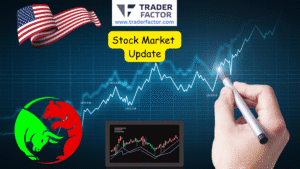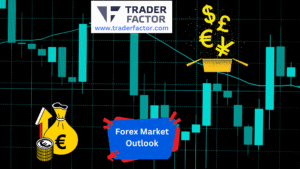The week is packed with multiple releases, including the PMI Reports and Nonfarm Payrolls Data. Prepare as we delve into the world of forex and explore the latest trends and predictions. Keep your eyes open for our exclusive insights and analysis as we navigate the market together.
Global markets were shocked on Monday as OPEC+ unexpectedly announced a production cut of over 1 million barrels a day, leading to a 6% surge in oil prices.
US equity futures took a hit while Treasury yields and the dollar rose. This seismic move by the group made investors quickly adjust to the potential of long-term inflationary pressure. As a result, the reverberations of this announcement were felt across multiple asset classes.
After assurances from OPEC+ that supply would remain constant, traders saw a policy-sensitive two-year Treasury yield jump eight bases, pushing it past 4.1%. This came after a first quarter in which Treasuries ended with falling yields and investors betting on interest-rate cuts.
Now, futures for the S&P 500 and Nasdaq 100 are down 0.3% and 0.6%, respectively, marking a sharp decline from Friday’s positive sentiment. Last week, the S&P 500 and Nasdaq 100 both saw significant gains, but it seems the markets are entering a new phase.
After a week of smooth sailing, Monday trading hit some turbulence with rising fears of inflation causing a bumpy ride. It’s a stark contrast to the optimism felt last week when the banking sector calmed down and US inflation cooled off.
Q1 Highlights and Recap
The first quarter of the year saw an increase in global market risk appetite, despite the looming threat of Silicon Valley Bank’s potential collapse. While the VIX market ‘fear gauge’ showed no signs of distress in the stock market by the end of Q1, the Treasury market equivalent MOVE index told a slightly different story.
At its highest point, MOVE rose by up to 65% after the SVB collapse. Fortunately, the government and the Fed came to the rescue, protecting depositors and significantly calming bond market volatility in the last weeks of Q1. With the dust settling, traders resumed their focus on what the Federal Reserve had in store for the upcoming future.
In a surprising turn of events, the Fed rate hike predictions have taken a dramatic nosedive from where they were just a few months ago. Traders are now eyeing a potential reduction of interest rates down to 4.25%, a sharp contrast to the 5% upper limit previously expected. As the banking industry calmed down, investors flocked to assets that would profit the most from this sudden shift in the market.
The Nasdaq 100 has been riding high lately, outperforming other markets with a successful 20% surge. This incredible three-month boost is unmatched since the early recovery after last year’s devastating pandemic crash.
Meanwhile, Bitcoin saw an impressive jump of over 70%, becoming a popular choice among traders. However, Treasury yields have dropped due to the Fed’s dovish stance, negatively affecting the US Dollar’s value.
Traders Expectations
The looming question on everyone’s mind – what’s in store for the worldwide markets? All focus is fixed on the US as we wait to see the repercussions of SVB’s downfall.
As the old adage goes, when the US sneezes, the rest of the world catches a cold. But with the possibility of a downturn, the forward strides made in Q1 could be undone for a variety of assets.
Nevertheless, if the economy manages to stay afloat, markets will need to make adjustments to account for the absence of rate cuts. The future of global markets is a constant balancing act, with each move holding potential for great rewards or uncertain outcomes.
The road ahead is shrouded in ambiguity as economists keep tabs on inflation forecasts and major central banks prepare to dial back their tightening measures. The tight labor market paves the way for unyielding inflation. Naturally, traders should keep an eye out for significant event risks looming on the horizon. So, what exactly are these key risks?
Q1 Market Performance Recap
Technical Outlook
The DXY index was a wild ride for the U.S. dollar in the first quarter of the year. In February, the index took a nosedive, sinking below 101.00 and marking its weakest point in almost a year. But the dollar fought back fiercely, surging to its highest level since November 2022.
Alas, this victory was fleeting, as the bulls and bears waged a ferocious battle, with the bears ultimately emerging victorious in the end. It was a heated tug of war, full of twists and turns that kept investors on their toes.
Meanwhile, the first quarter of 2023 saw the Australian Dollar hovering around its starting point, following a rollercoaster ride between 0.6565 and 0.7158.
Meanwhile, Bitcoin enthusiasts have made a huge comeback, roaring back from a lacklustre 2022 with a 70% increase in Q1. Technical indicators suggest that the bullish run may extend into Q2.
The Yen has also put up a strong showing, displaying resilience in the closing month of Q1 and indicating a potentially fruitful period ahead. As for the wider financial landscape, Q1’s price movements were characterized by fluctuations between key levels, while there are indications of a long-term downtrend continuing into Q2 – albeit with a few signs of a slowdown.
As we enter the second quarter, a gloomy aura surrounds the U.S. dollar. It faces a hurdle as it struggles to maintain key technical support, which could result in a worrisome breakdown. The gravity of this situation cannot be understated, as it could bring the February lows to the forefront.
Fundamental Outlook
The first quarter of 2023 saw some interesting twists and turns in the financial world. Gold prices skyrocketed due to tumbling rate expectations and banks’ financial turmoil. And although the British Pound has barely inched upward since Q1, the euro may have some room for improvement in Q2, despite certain limitations.
Meanwhile, the tech-heavy Nasdaq 100 outperformed the Dow Jones as aggressive rate-cut bets were spurred by SVB’s collapse. But, the actions of the Fed may not align with this scenario. So, what’s next for these financial powerhouses? Will bulls continue to drive gold prices up? And will we see any major moves from the GBP or Nasdaq 100? Only time and market forces will tell.
This Week Ahead:
Hold onto your hats! This week is jam-packed with key events that are sure to impact the market. Get ready for a ride with a wide range of events, from the Eurozone S&P Global Eurozone Manufacturing PMI to the US construction spending, ISM manufacturing, and light vehicle sales.
Keep your eyes on the ball for the Eurozone PPI and the US factory orders and durable goods. And don’t forget the Australia rate decision and the Cleveland Fed President Loretta Mester’s speech on Tuesday!
Wednesday brings us the Eurozone S&P Global Eurozone Services PMI, followed by the US trade and the UBS annual general meeting.
On Thursday, buckle up for the US initial jobless claims and the St. Louis Fed President James Bullard’s speech.
And finally, on Friday, we will get a glimpse of the US unemployment, and nonfarm payroll data. Just remember, some markets will be closed on Good Friday, including US stock and bond markets.
Previous Week Performances
Currencies
The Bloomberg Dollar Spot Index saw a 0.3% increase, leaving currencies scrambling to keep up. The euro fell by 0.4% to sit at $1.0794, while the Japanese yen followed suit with a 0.4% drop to 133.40 per dollar. Even the offshore yuan couldn’t avoid the trend, decreasing by 0.4% to reach 6.8974 per dollar. The Australian dollar, trying to hold its ground, saw a smaller 0.2% decline to land at $0.6669. It seems that the almighty dollar is reigning supreme in the current market.
Movers In The Market
The S&P 500 futures took a dip by 0.3% in Tokyo, posting a 1.4% growth on Friday. Meanwhile, Nasdaq 100 futures dropped by 0.6% despite its 1.7% hike on Friday. Over in Japan, the Topix index made a 0.5% gain which complemented Australia’s S&P/ASX 200 Index’s 0.8% climb. However, Hong Kong’s Hang Seng Index suffered a slight loss of 0.3%, while in China’s Shanghai Composite Index, things looked up with a 0.4% increase.
Cryptos
The value of Bitcoin took a dip, marking a 1.2% drop to $27,735.03. The digital currency giant wasn’t the only one to stumble, as Ether also faced a minor setback, falling 0.8% to $1,775.87. It seems the financial world can be fickle, and even the most robust commodities can take stumble from time to time.
Commodities
In an interesting turn of events, West Texas Intermediate crude experienced a significant boost of 5.5% to reach a new high of $79.84 per barrel. Meanwhile, spot gold took a tumble and fell by 0.8% to hit a new low of $1,953.19 per ounce. It seems the commodities market is fluctuating quite unexpectedly, leaving investors on the edge of their seats.
Bonds
Global bond yields move higher, with the 10-year US Treasury yield climbing five basis points to 3.51%. Meanwhile, in Japan, their equivalent rate rose three basis points reaching 0.35%, while Australia’s remained largely unchanged at 3.29%.

Compare the Best Laptops for Forex Trading in 2023
Forex for Beginners: What You Need to Know To Get Started
Best Trading Sessions At Forex Markets
Factors That Affect The Exchange Rate In 2023
Disclaimer:
All information has been prepared by TraderFactor or partners. The information does not contain a record of TraderFactor or partner’s prices or an offer of or solicitation for a transaction in any financial instrument. No representation or warranty is given as to the accuracy or completeness of this information. Any material provided does not have regard to the specific investment objective and financial situation of any person who may read it. Past performance is not a reliable indicator of future performance.

















